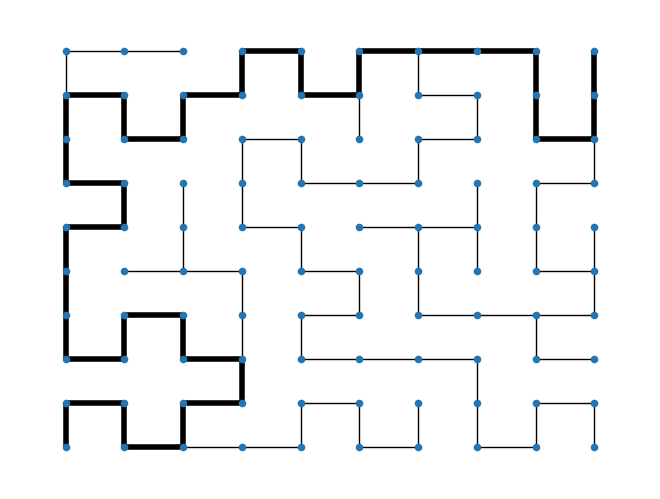Animation des parcours
Contents
Animation des parcours#
Ce notebook, rédigé en Python, illustre les parcours de graphes (DFS, BFS). Le module cpge utilisé est disponible ici.
Parcours en profondeur#
import cpge.graph
G = cpge.graph.random_list() # graphe aléatoire représenté par liste d'adjacence
cpge.graph.draw(G)

cpge.graph.anim_dfs(G) # parcours en profondeur depuis le sommet 0
Parcours en largeur#
cpge.graph.anim_bfs(G)
Labyrinthe#
Génération par parcours en profondeur#
On souhaite générer un labyrinthe parfait (possédant un unique chemin de point à un autre - c’est-à-dire dont le graphe sous-jacent est un arbre) comme celui ci-dessous.
Pour cela, on peut faire partir un parcours en largeur sur un graphe “grille” de taille \(n\times p\) et ne conserver que les arêtes traversées par le parcours.
À chaque appel récursif de dfs, on s’applique aléatoirement sur un des \(4\) voisins qui n’a pas encore été visité.
import matplotlib.pyplot as plt
import networkx as nx
import random
def generate_labyrinth(n, p):
G = nx.Graph()
G.add_nodes_from((i, j) for i in range(n) for j in range(p))
visited = [[False]*p for _ in range(n)]
def dfs(i, j):
visited[i][j] = True
neighbors = [(i+1, j), (i-1, j), (i, j+1), (i, j-1)]
random.shuffle(neighbors)
for x, y in neighbors:
if 0 <= x < n and 0 <= y < p and not visited[x][y]:
G.add_edge((i, j), (x, y))
dfs(x, y)
dfs(n - 1, 0)
return G
def draw(G, **keywords):
plt.clf()
nx.draw(G, pos={p: p for p in G.nodes()}, node_size=20, **keywords)
plt.show()
n = 10
draw(G := generate_labyrinth(n, n))

Résolution#
Par parcours en profondeur#
On cherche maintenant à trouver le chemin de l’entrée (case en bas à gauche) à la sortie (en haut à droite). Pour cela, on effectue encore un parcours en profondeur depuis l’entrée, jusqu’à trouver la sortie :
def solve_labyrinth(G, n):
visited = [[False]*n for _ in range(n)]
path = []
for i,e in enumerate(G.edges):
G.edges[e]['index'] = i
def dfs(i, j):
if i == n - 1 == j:
return True
visited[i][j] = True
neighbors = [(i+1, j), (i-1, j), (i, j+1), (i, j-1)]
random.shuffle(neighbors)
for x, y in neighbors:
if 0 <= x < n and 0 <= y < n and (x, y) in G[(i, j)] and not visited[x][y]:
if dfs(x, y):
path.append(G[(i, j)][(x, y)]['index'])
return True
return False
dfs(0, 0)
return path
path = solve_labyrinth(G, n)
widths = [4 if i in path else 1 for i in range(len(G.edges))]
draw(G, width=widths)

Animation de la résolution du labyrinthe par parcours en profondeur :
import networkx as nx
import matplotlib.pyplot as plt
import matplotlib.animation
from IPython.display import HTML
def anim_graph(G, widths):
fig, ax = plt.subplots(figsize=(20,12))
plt.close()
def update(frame):
ax.clear()
nx.draw(G, ax=ax, pos={p: p for p in G.nodes()}, node_size=700, width=widths[frame])
ani = matplotlib.animation.FuncAnimation(fig, update, frames=len(widths), interval=80)
return HTML(ani.to_jshtml(default_mode="once"))
def solve_labyrinth_dfs(G, n):
widths = [1]*len(G.edges)
visited = [[False]*n for _ in range(n)]
frame_widths = []
for i,e in enumerate(G.edges):
G.edges[e]['index'] = i
def dfs(i, j):
if i == n - 1 == j:
return True
visited[i][j] = True
neighbors = [(i+1, j), (i-1, j), (i, j+1), (i, j-1)]
random.shuffle(neighbors)
for x, y in neighbors:
if 0 <= x < n and 0 <= y < n and (x, y) in G[(i, j)] and not visited[x][y]:
widths[G[(i, j)][(x, y)]['index']] = 6
frame_widths.append(widths.copy())
if dfs(x, y):
return True
widths[G[(i, j)][(x, y)]['index']] = 1
frame_widths.append(widths.copy())
return False
dfs(0, 0)
return frame_widths
anim_graph(G, solve_labyrinth_dfs(G, n))
Par parcours en largeur#
from collections import deque
def solve_labyrinth_bfs(G, n):
widths = [1]*len(G.edges)
visited = [[False]*n for _ in range(n)]
frame_widths = []
for i, e in enumerate(G.edges):
G.edges[e]['index'] = i
q = deque([(0, 0)])
while len(q) > 0:
i, j = q.pop()
if i == n - 1 == j:
break
visited[i][j] = True
neighbors = [(i+1, j), (i-1, j), (i, j+1), (i, j-1)]
random.shuffle(neighbors)
for x, y in neighbors:
if 0 <= x < n and 0 <= y < n and (x, y) in G[(i, j)] and not visited[x][y]:
widths[G[(i, j)][(x, y)]['index']] = 6
frame_widths.append(widths.copy())
q.appendleft((x, y))
return frame_widths
anim_graph(G, solve_labyrinth_bfs(G, n))


